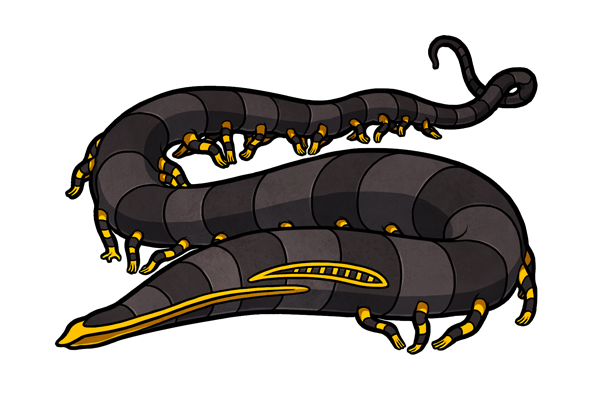

hokokodroni
the laborers
prefix hokoko suffix droni
fres retoride peto
physical appearance
The hokokodroni /həʊˈkəʊkəʊ,droʊni/ is a long, brightly-colored stranger with upwards of forty legs. Its thin skin is rubbery and firm to the touch, while its dark and fibrous flesh is slick and interlaced only with a network of black, gristle-like veins. Although not toxic to the touch, the hokokodroni's flesh is poisonous when ingested. The strain's odor is similar to gasoline, with the intensity of this odor varying between individuals.
The hokokodroni regenerates from most injuries within several days, with minimal "glossiness" of scarred areas, which fade within a month. It is not susceptible to changes in heat, and its presence extinguishes any flame placed near its body. In addition, any part of the hokokodroni's body, if cut off, can regrow to form an entirely new hokokodroni; these "clones", however, have a lifespan only one-tenth that of the original individual.
industrial clanking from three blocks away.

environment and generation
The hokokodroni appears in dark, garden-like areas,㇂ and exclusively at night. Its body generates from a small form several inches underground, growing to full size over a period of one to four hours, and emerging from the earth to immediately engage in a series of self-grooming behaviours, rubbing its head against its back, twining its tail in knotting motions, and using its small hands to stroke its underside until shiny.
㇂ Produced from black earth, night parks overlooking sub-towns. Rows of tin cans. Lanterns on strings. Wires that stretch from street pole to street pole.
Ben Gabriel. Secondary Poisoning.
behaviour and effects
The hokokodroni's disposition is ordered but subtly jocund. It moves throughout its territory in routine paths, remaining observant of its surroundings, without expressing timidity or skittishness. Its movements resemble those of a millipede or centipede, and emits a xylophone-like, musical cadence, with each note corresponding to one of its footsteps. These melodies appear to have communicative function between individuals, with hokokodroni engaging in foot-tapping upon meeting one another for the first time. Aside from these initial meetings, however, the hokokodroni is largely asocial. Each individual maintains a distinct territory, moving as far from one another as possible within this range, provided such room exists. It does not dispute its border, and even when environmental factors prevent large territories, hokokodroni do not encroach upon their neighbors' domains.
The hokokodroni rests at periodic intervals, curling itself into a tight ball or finding a crevice in which to press its body. Immediately prior to dormancy, it uses its foremost limbs to play a series of tranquil, music box-like notes. This self-soothing behaviour occurs only when alone; it does not share its songs with sensitives in any way.
The hokokodroni hides from all animals larger than a beetle, including mice and bats. Among mammals, it tolerates only the smallest of shrews. This strain appears to incite some aggressive behaviours in these small creatures, which attempt to bite its feet, although the hokokodroni itself only loosely avoids such attacks.
interactions with sensitives
For the most part, the hokokodroni displays no real interest in sensitives themselves, although certain individuals do draw its attention. Each hokokodroni appears to have its specific curiosities – some are drawn to sensitives with very dark skin, while others may take an interest in extreme heights, or particular eye colors.
Once a sensitive has caught the hokokodroni's attention in this way, the stranger will keep its head fixated on the sensitive's location (with frequent turns and adjustments of angles, sometimes even looking at the person upside-down) while it circles them from a distance. The hokokodroni never engages in direct physical actions towards sensitives.
The hokokodroni seeks out any small object touched by a sensitive within the past 74 hours, which it gathers and hides in scattered and varying locations. A pen might be buried in a shallow hole underground, while a bottle might be pulled from the trash and tucked away inside an open pipe. The hokokodroni does not tend to return to these items later, nor does it build shrines or caches, and always choses hiding places which obscure the item completely from view. The hokokodroni appears able to tell when an object has been touched by a sensitive even when it does not observe the actual contact itself, and, in addition, tends not to gather items while being watched by a sensitive, instead waiting for isolation.
The hokokodroni is also fascinated by the corpses of sensitives, and, upon encountering one, forces itself between their jaws and down their throat, exuding a caustic substance from its body that allows the flesh around it to part. Once fully encased within the sensitive's flesh, the hokokodroni allows its body to be dissolved, staining the sensitive's flesh.
The hokokodroni has no interest in the corpses of non-sensitives.
aging and death
The hokokodroni's aging process is almost invisible, growing only vaguely slowing in its motions and less curious about the world around it, its periods of dormancy becoming both more frequent and longer in duration. At the end of its life, its flesh peels off in ribbons in an abrupt and brutal display, its body collapsing to the ground and breaking apart into large chunks. The hokokodroni's toxicity becomes fully apparent as the decomposition of its corpse spoils the ground beneath it and prevents plant growth in its immediate vicinity. Its nearby companions, when present, adjust their territories accordingly and without conflict.



